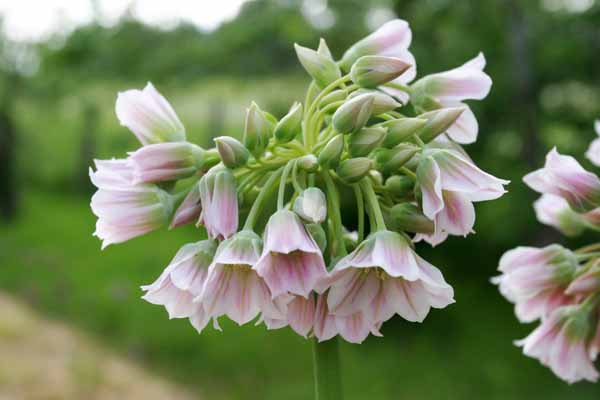Nectaroscordum tripedale: Red Data Book of Armenia

EN* B 1 ab(iii,iv,v) + 2 ab(iii,iv,v)
Category. Endangered species. The extent of occurrence is less than 20000 km2, the area of occupancy is less than 2000 km2. The species faces decline of the extent of occurrence and the area of occupancy caused by anthropogenic factor. The category has been upgraded to EN as a result of obvious decline of the quantity. It was included in the first edition of the Red Data Book of Armenia under Category 2: Rare species. It is not included in the Annexes of CITES and that of the Bern Convention.
Description. Bulbous plant. Stem 50–150 cm. Leaves 3–5, linear– lanceolate, sharply carinate. Inflorescence fasciculate, diffuse. Perianth campanulate, 13–15 mm long; segments green at base, green or pink in upper part; midrib purple or green. Very decorative plant.
Distribution. In Armenia it is found in Aragats (Amberd), Aparan (surroundings of Arzakan, Aghveran, Buzhakan villages), Darelegis (Djermuk) and Meghri (surroundings of Aygedzor village) floristic regions. EOO is 7500 km2, AOO is 28 km2, the number of locations is 5. Beyond the borders of Armenia it is distributed in Nakhichevan, Dagestan, East and South–East Anatolia, North Iraq, North–West and South Iran.
Ecological, biological and phytocoenological peculiarities. Grows from middle to sub–alpine belts, at the altitudes of 1700–2500 meters above sea level, in forest glades, meadows, in shrubs, on the rocks. Flowering from June to July, fruiting from July to August.
Limiting factors. Restricted extent of occurrence and area of occupancy, loss/degradation of habitats caused by being situated in recreation zone and by intensive collection for sale.
Conservation actions. One population is growing on the territory of National park "Arevik". Necessary: monitoring of the population state.
Suggestions
 The Ministry of Environment sent a letter international partners to draw their attention to the real danger of environmental disasters as a result of Azerbaijan's large-scale aggression towards the territory of Armenia
The Ministry of Environment sent a letter international partners to draw their attention to the real danger of environmental disasters as a result of Azerbaijan's large-scale aggression towards the territory of Armenia
 Vicia pisiformis: Red Data Book of Armenia
Vicia pisiformis: Red Data Book of Armenia
 Vavilovia formosa: Red Data Book of Armenia
Vavilovia formosa: Red Data Book of Armenia
 Trigonella capitata: Red Data Book of Armenia
Trigonella capitata: Red Data Book of Armenia
 Trigonella astroides: Red Data Book of Armenia
Trigonella astroides: Red Data Book of Armenia












